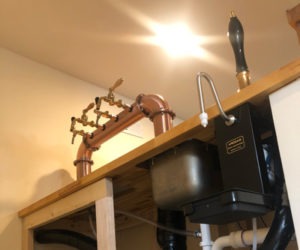Inline Refractometer: Getting real-time density readings
The idea of this project was to measure the Brix of a wort inline during recirculations and transfer during the various processes of a brew day. For example it could be used as part of the sparging process, so that the sparge can be stopped when the standard gravity (SG) approaches 1.008 (2.1 °Brix) to prevent the extraction of tannins. I can measure the mash’s first running’s to be able to see if the conversion efficiency was higher or lower than expected. Additionally, the principle could also be utilized during fermentation assuming appropriate formulae are utilized to account for the presence of alcohol. That one is still in theoretical phase though.

For this build, I utilized a typical non-digital brewing refractometer along with a Raspberry Pi Zero and camera to image the refractometer output. If you are unfamiliar with Raspberry Pi technology, then I highly recommend looking into it. The capacity of these small boards is incredible. But back to the project at hand . . . the temperature of the liquid pumped through the inline refractometer needs to be measured as the reflective property of water changes with increasing or decreasing temperatures. I’m using a DS18B20 1-wire temperature probe at the outlet of my brewing vessel near the butterfly valve so I can track this and later use it in my correction calculations. I tried to correct for the effect of high temperatures on the Brix scale of monitoring sugar density using a simple calibration process.
Unfortunately for everyone reading, this build is still in beta mode. Further tests will need to be conducted to determine the accuracy of this system at various temperatures using more comparisons to a standard digital refractometer, for example. My system’s mash temperature readings are still a little off when compared to my digital refractometer. Additionally, other improvements would include investigating plastics most suitable for upper-end mash temperatures of around 70–80 °C (158–175 °F) to prevent warping along with better seals. I unfortunately had issues with leaks through the lid at higher pressures when I increased flow rates, so a different type of lid may need to be investigated too. A glass jar could be the solution, but I am not comfortable cutting a glass jar.
For this build, I utilized a typical non-digital brewing refractometer along with a Raspberry Pi Zero and camera to image the refractometer’s output.
Also, darker beers are problematic as the ability to see through the jar is a limiting factor with this design . . . like trying to perform a starch conversion test on a stout. A thinner, squared compartment could possibly allow readings on dark-colored beers.
That aside, I’m excited for this project. There are several advantages to obtaining real time sugar readings. Being able to see that running’s gravity is approaching the danger zone of 1.010 (2.6 °Brix). Or the fact that I can ascertain that my gravity readings are lower than expected during sparge and I will need to make a kettle sugar addition to correct the problem and to check my grain crush for potential inconsistencies.
Tools and Materials
- Transparent plastic jar
- (2) ½-in. bulkhead
- M32 cable gland
- 1-mm (1⁄32-in.) drill bit
- 11-mm (7⁄16-in.) drill bit
- 21-mm (13⁄16-in.) Q-Max hole punch
- 32.5-mm (11⁄4-in.) Q-Max hole punch
- Refractometer
- DS18B20 temperature probe
- Raspberry Pi Zero
- Raspberry Pi camera
- Mini tripod


